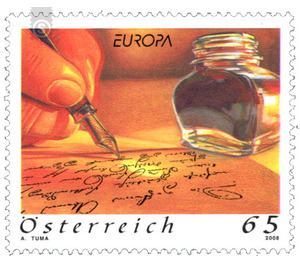CEPT - Austria / II. Republic of Austria 2008 - 65 Euro Cent
Theme: Post & Philately
| Country | Austria / II. Republic of Austria |
| Issue Date | 2008 |
| Face Value | 65.00 |
| Edition Issued | 800,000 |
| Printing Type | Photogravure |
| Stamp Type | Commemorative |
| Item Type | Stamp |
| Chronological Issue Number | 2088 |
| Chronological Chapter | OOS-OE2 |
| SID | 857167 |
| In 58 Wishlists | |
Letters - Business Letters, Private Letters, Love Letters, Threatening Letters, Letters of Thanks, Reminder Letters, Congratulations, Condolence Letters, Teaching Letters, Open Letters, Wanted Letters, Money Letters, Literary Letters, Short Letters, Billets, Emails, S.M.S. ... since the man of writing is knowledgeable, there is also the letter as a written notice to absent persons. Oldest correspondence have been handed down to us from ancient Egypt and from Babylon, written on papyrus or on clay tablets. Greeks and Romans carved their characters on waxed wooden tablets. Indians and Chinese used palm leaves early on. Parchment was used in the European Middle Ages until the paper gradually became accepted. To protect the contents of the letter from prying eyes, they tied up the pens and parchment scrolls and sealed them with wax; in the 15th century the sealing wax from China came into use in Europe. For the insertion of letters in an envelope invented in 1820 the Englishman Brewer the envelope. For short messages the postcard prevailed. Today, the new electronic media open up further possibilities for written communications. For a long time in the Middle Ages Latin was the predominant letter language of the monastic and princely writing rooms. In the 14th century the bourgeois letter began to take hold, and with it the German language. The mostly unscripted dictated a writer, a reader arranged the contents of the letter. The letters were transmitted by messengers, who were mostly familiar with the recipient, so that address information was rather inaccurate. From the time of the Reformation, broader sections of the population used letter writing. Letter writing developed into its own literary form in the 18th century, the "century of the letter". The style was influenced by the taste of an educated middle class and covered all layers and estates. With the revolutionary year 1848, the sober form of the letter prevailed and showed quite the character of the hurry. With the technical development new forms of organization of the post office and the transport arose and let the correspondence grow in unimagined extent. The industrially produced envelope now contained a precise address and any transport and franking marks. The next change took place with the introduction of the postage stamp (1850) as a transport fee and the cancellation as proof of implementation.


